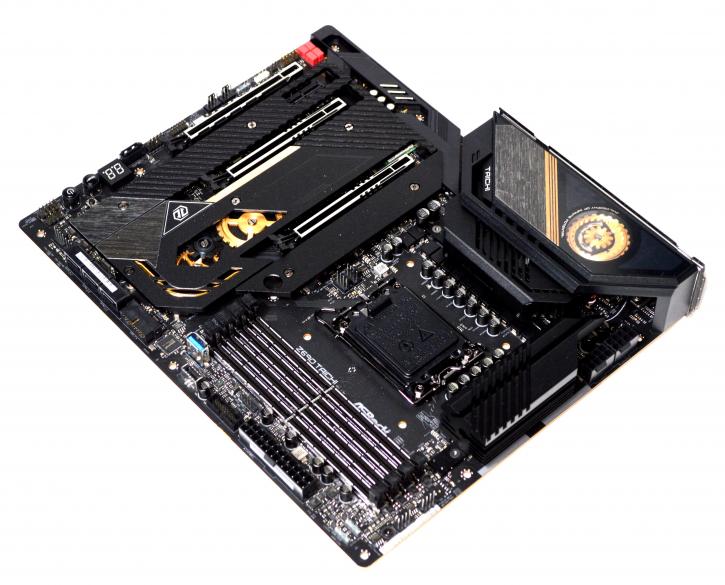Final Words & Conclusion
Conclusion
Is the ASRock Z690 Taichi revolutionary or evolutionary? We feel it's the latter. It’s a natural extension of the Z490 Taichi and Z590 Taichi. Is that bad? Nope. But on the other side – you’d like some fresh air, not the remake/refresh using another chipset. It was exciting the first time I’ve encountered the series, but now I feel a (130 USD more expensive than the predecessor) déjà vu. Of course, ASRock Z690 Taichi is not a bad motherboard; certainly not. It looks great (especially with this moving cog/gear), and there are three addressable and one regular LED strip header for RGB lovers. You get nice access to overall eight 4-pin headers for the fans of the fans. The DDR5 slots support up to 128 GB of RAM and handle up to DDR5-6400 memory. The ASRock Z690 Taichi has two PCIe 5.0 x16 slots and one 4.0 x16 (x4 speed). The audio for this board does well enough with the Realtek ALC1220 codec (but we would expect a newer one in that budget, luckily there is a dedicated ESS SABRE9218 DAC). The M.2 slots support two PCIe 4.0 x4 drives and one 3.0 x2 drive – overall, only three, and the third one is 3.0 x2 (not x4), so that’s a significant drawback. The price of the ASRock Z690 Taichi is about 589 USD, which makes it very expensive. Also – you’ll find seven (not the usual eight) SATA ports and only six (not eight) USB Type-A ports. You’ll get two Thunderbolt 4.0 ports; that’s not a standard. You might want to know that this board has robust, 19+1 power delivery, no complaints in that department.
DDR5 Memory
Memory compatibility should not and likely will not be an issue as long as you stick to recently released DIMMs. Well, there’s still not so much available at the market, and the stocks are very low.
Power consumption
The Intel Core i9 12900K doesn’t shine in the power consumption department, at least in a heavy load. In games, it’s a different story (but for that – you need to check Hilbert’s review). It’s a 125 Watt TDP processor. With the system at idle with a GeForce RTX 3080 installed / 32 GB memory / SSD and the Z690 motherboard, I hovered at roughly Watts in IDLE. The Z690 doesn’t benefit it (and why would it?), so when we stressed the processor, we reached 300 Watts of power consumption. We used the maximum CPU that is available yet for the Z690 chipset.
Performance & tweaking
To get to 5.1~5.2 GHz on all cores, you will probably need at least 1.35, or closer to 1.4-1.45 V on the processor. This makes power consumption grow rather rapidly. If you plan a tweak at that 5.2 GHz mark, you will need LCS (and it would be better a 360/420 mm one). The process of OC that Z690 offers is easy to use: you increase the CPU voltage and multiplier, and that’s it. Another plus for the Intel platform is that they have refined their memory controllers over the years. Pop in anything, select the XMP, and you have more than a 90% chance it’ll work straight out of the box with high-speed memory. The temperatures of VRMs are good here (also thanks to the VRM fan), even with an overclocked CPU.
Final words
The ASRock Z690 Taichi is the greatest model from Asrock’s Z690 line. It contains an integrated I/O shield, superb RGB implementation (with three aRGB connectors and one RGB compatible), PCIe 5.0 compatibility, PCIe 4.0 NVMe disks support (you may install two of them, one PCIe 3.0 drive), and 7 SATA ports. The buttons for power/reset/clear CMOS can also come in handy when overclocking. You get a 2.5 Gbe Ethernet but no Wi-Fi compatibility. The looks are nice and should fit most of the builds. Asrock Z690 Taichi has a great power delivery with 20 phase VRM with 105A MOSFETs, giving 1995A. That should be enough even for the 12900K and most possibly also the upcoming new processors for socket 1700. The power delivery section is cooled with one 30 mm fan, but the VRMs would be cool even without its aid. You will get two Thunderbolt 4.0 ports – that’s a great addition. The audio performance is more than decent, but we expect fresher than ALC1220 (although it’s good that there’s an ESS SABRE9218 DAC for Front Panel Audio). Overall there are eight fan headers – so you shouldn’t be disappointed in that department (but the location of the CPU fans headers is rather odd). The price is steep (but that’s usually a norm for the DDR5 based Z690 motherboards). 589 USD is the high-end of the market, and the competition is very strong, like MSI Z690 Unify, Asus Maximus Z690 Hero, or Biostar Z690 Valkyrie. As for the things we didn’t like, there are only six “regular” USB ports (but on the other side, there are two Thunderbolt 4.0 ports that we mentioned above), which definitely cannot be enough for some. There are seven, not the usual eight SATA ports, but as the M.2 is usually a better option – it’s not a major issue. Speaking of the M.2 – you’ll find only three of them (other Z690 boards have four), with the last one being compatible only with PCIe 3.0 x2, not x4 like the standard. The ASRock Z690 Taichi performed a bit above average; the OC was at a good level for this CPU sample of Core i9 12900K, so overall, we can give an “Approved” award. Why not the “Recommended”? The ASRock Z690 Taichi is a very solid (especially due to the used VRM) option, but nothing that would stand out (besides Thunderbolt 4.0). It’s a bit too expensive for what it offers (ALC 1220, three M.2 slots, 6 USB Type-A ports), especially since it looks like a refresh of the Z590 Taichi. While the previous time was novel, this time was not, and we expected something more... perhaps a refresh or some innovation is advised.
Handy related downloads:
- Sign up to receive a notification when we publish a new article
- Or go back to Guru3D's front page



